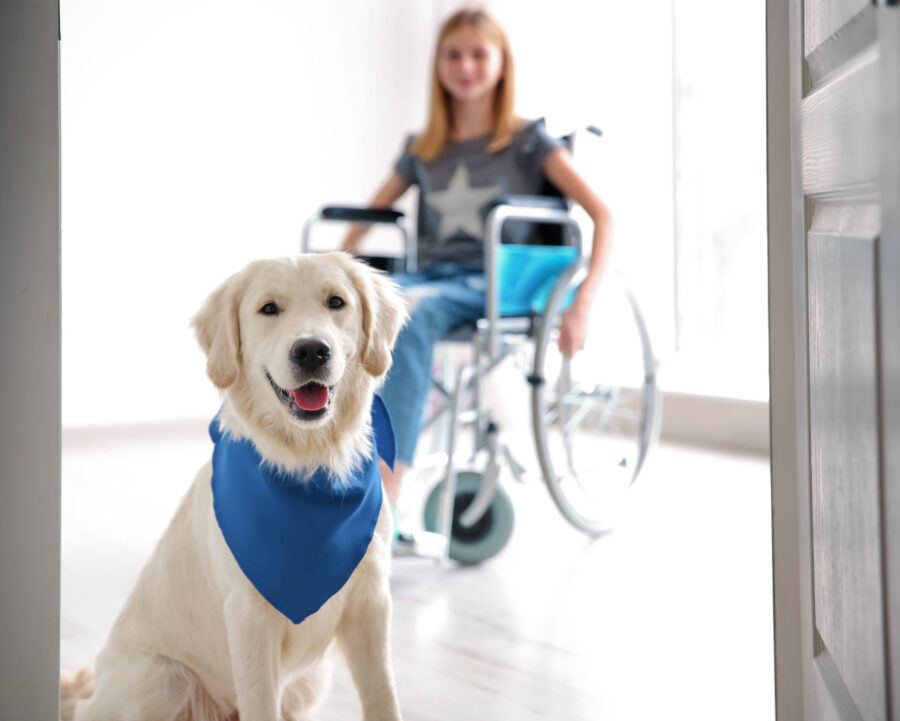September is National Service Dog Month, and RAWZ Natural Pet Food wants to say “Thank You” to all the service dogs who enhance the quality of life and independence for the people they help!
Service dogs assist hundreds of thousands of Americans every year, and each September, National Service Dog Month is a time to honor and recognize their invaluable contributions. Service dogs receive special training and certification to perform specific tasks for an individual with disabilities. Depending on the needs of the person, a service dog can perform hundreds of tasks centered on things like alerting, detecting, responding, and more. This National Service Dog Month, RAWZ Natural Pet Food wants to recognize eight ways the hard-working service dogs of America help people!
1. Mobility Assistance
One of the many valuable tasks service dogs can perform is mobility assistance. In general, they help individuals with physical disabilities navigate their environment, which can include:
- Providing balance support
- Retrieving and delivering items
- Opening or closing doors
- Pressing buttons
- Turning on lights
- Retrieving mobility aids, such as a walker
2. Diabetic Alerts
Service dogs can also help people with diabetes. For example, they can learn to detect changes in a person’s blood sugar levels and alert the person to hyperglycemia and hypoglycemia. In case of medical emergencies, service dogs can also seek help or alert others nearby.
3. Psychiatric Support
When it comes to mental health conditions, such as post-traumatic stress disorder, service dogs can perform many tasks. They can provide a calming presence, interrupt harmful behaviors, guide their person to an exit, prevent people from approaching, provide deep pressure therapy, and beyond.
4. Autism Support
There are also several ways service dogs can support autistic individuals. They can provide safety, emotional support, sensory regulation, routine, help with tasks, companionship, behavioral cues, and even comfort during social interactions.
5. Hearing Assistance
Safety is one of the most important goals of a service dog helping a person with a hearing impairment. They can alert their handlers to important sounds like alarms and sirens, as well as doorbells and other environmental noises. In social situations, service dogs can also alert their handler that someone is calling their name.
6. Guiding
Guide dogs may be one of the most commonly known service dogs. These dogs provide support to people with visual impairments by helping them navigate their surroundings safely, which includes:
- Leading them through their environment
- Avoiding obstacles
- Providing directional assistance
- Navigating public transportation systems
- Retrieving items
7. Allergy Detection
For people with severe allergies, service dogs can learn to detect allergens, identify them in the environment and foods, retrieve medications, and seek help in case of an allergic reaction.
8. Seizure Alerts and Response
Some service dogs learn to detect the onset of a seizure. Not only can they alert their handler to prepare for the event, but they can also call for help, retrieve medication, prevent falls and injuries, and provide assistance and comfort afterward.
RAWZ: Supporting the Dogs Who Support People
RAWZ Natural Pet Food is a proud supporter of service dogs. The company donates 100% of its profits (less taxes and reserves) to four main causes, including service dog programs. In fact, in September 2024, they donated $50,000 to National Service Dogs, a charity training Certified Service Dogs to help children with autism, veterans, and first responders with PTSD.
Visit RAWZ to learn more!

Post Views: 3
Animal Wellness is North America’s top natural health and lifestyle magazine for dogs and cats, with a readership of over one million every year. AW features articles by some of the most renowned experts in the pet industry, with topics ranging from diet and health related issues, to articles on training, fitness and emotional well being.
